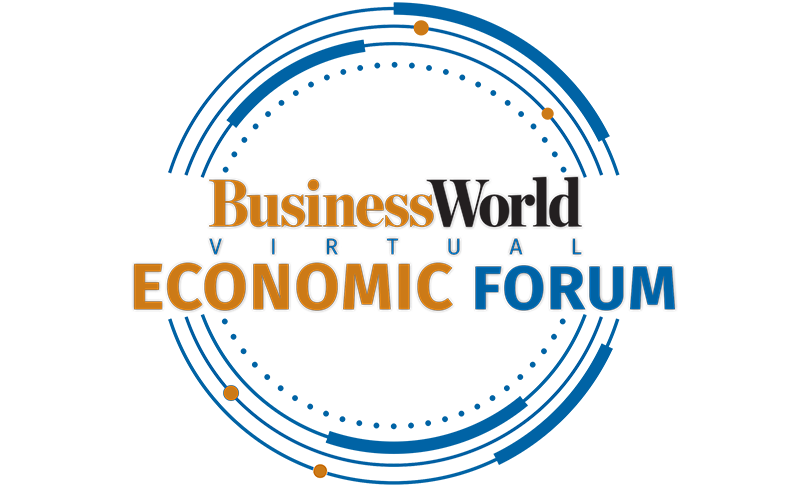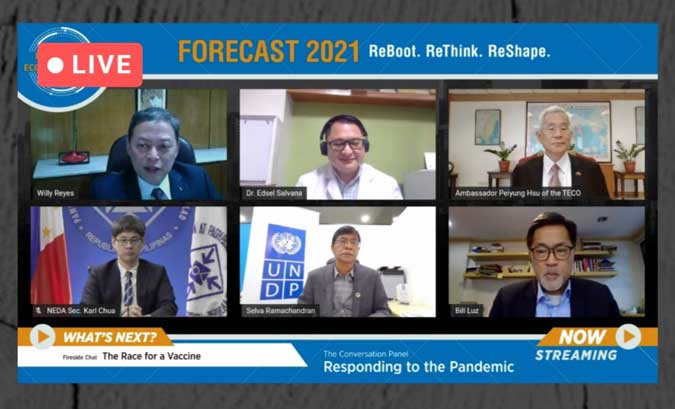
By Beatrice M. Laforga, Reporter
THE Philippine economy may go back to its pre-pandemic growth trend starting mid-2022, on the back of strong fundamentals and an expected rebound in consumer confidence amid optimism that a coronavirus vaccine will be available by next year, experts said on Wednesday.
Socioeconomic Planning Secretary Karl Kendrick T. Chua said they expect the economy to be strong enough to go back to its 2019 levels by mid-2022 — around the time President Rodrigo R. Duterte steps down from his post.
“There will be scars and delays but putting all the numbers together, we are seeing a return in the 2019 levels sometime in the middle of 2022. We can accelerate that further if we can focus on the recovery programs,” Mr. Chua said during a panel discussion at the BusinessWorld Virtual Economic Forum.
Mr. Chua said the economy is projected to grow by 6-7% next year coming from a low base in 2020. The economic team is keeping a 6.5-7.5% growth rate for 2022.
“The opening of the economy appears to be the most important policy that we should be pursuing so long as we do it as safely as possible,” he said.
Since the strict lockdown began easing in June, the government has continued to relax quarantine restrictions to help the ailing economy recover at a quicker pace.
The crisis will leave many economic scars, particularly the impact of delays in education that may hamper future productivity and income of families in the next few years.
Restoring consumer confidence is key to recovery, Mr. Chua said, noting the economy is largely consumption driven.
He said the government will prioritize strengthening the capacity of the healthcare system to accommodate COVID-19 patients, as this would help reassure the public.
As the rebound in consumer and business confidence would depend on the availability of a vaccine, herd immunity can be achieved by vaccinating 70% of the total population, according to Edsel T. Salvana, director of the Institute of Molecular Biology and Biotechnology at the National Institutes of Health at the University of the Philippines Manila.
 Mr. Salvana said a vaccination program may start as early as April, prioritizing the vulnerable sector and gradually covering the general population towards the end of 2021.
Mr. Salvana said a vaccination program may start as early as April, prioritizing the vulnerable sector and gradually covering the general population towards the end of 2021.
“So long as we can keep our hospitals from being overwhelmed, we will continue to do better in managing these severe cases. We have been working on vaccines and more data is coming out. The projection is that in the second quarter we will have some vaccine availability. We are learning to live with the virus but the danger is really in complacency and vigilance is crucial,” Mr. Salvana said.
The government plans to borrow P73.2 billion to buy coronavirus disease 2019 (COVID-19) vaccine for 60 million Filipinos.
Global drugmakers such as AstraZeneca and Pfizer, Inc. have reported their coronavirus vaccines were tested to be 90-95% effective.
“With the high efficacy rate that we are seeing with the vaccines, we might be able to eliminate this. I’m very optimistic. We’re now seeing 90-95% so there’s a real chance of herd immunity,” Mr. Salvana said.
Better coordination among the private and public sectors will also play a crucial role in economic recovery according to BusinessWorld President and CEO Miguel G. Belmonte.
“There is growing recognition, and we fully concur, that the impact of COVID-19 is such that it requires a whole-of-government, whole-of-society response,” Mr. Belmonte said in his keynote speech at the start of the BusinessWorld Virtual Economic Forum.
Børge Brende, president of the Word Economic Forum, said the Philippines can capitalize on its vibrant young population and great relationship with the biggest economies as it bounces back from this year’s slump.
“We know that if there is COVID-19 anywhere, it will be everywhere so it’s really a global responsibility to fight this pandemic and in many places in the world, we are still just in the crisis mode. We are not in the recovery phase yet, we are fighting the pandemic,” Mr. Brende said in a separate speech at the same forum.
Bernardo Mariano, Jr., the chief digital and information officer at the World Health Organization (WHO), stressed the need to harness technology in ramping up the response to the pandemic as the health sector also goes through its digital transformation amid the crisis.
“We live in a world where equity, where access to broadband, is still far from ideal. Let’s make sure that those inequities and inequalities are reduced,” he said.
Moving forward, Guillermo M. Luz, the chief resilience officer at the Philippine Disaster Resilience Foundation, said the pandemic has emphasized the importance of establishing business continuity plans, particularly for micro-, small- and medium-sized enterprises.
“It’s not a problem for large corporations because they are used to putting business continuity programs for themselves… so we concentrated a lot on MSMEs (to help in creating plans) and how to keep them going,” he said.
“What we found in this pandemic is that it has forced people to make adjustments, especially on digital transformation, far faster than they originally anticipated,” he added.

